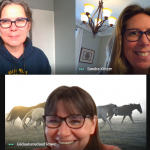
I am a survivor of a concentration camp. My eyes saw what no person should witness: gas chambers built by learned engineers. Children poisoned by educated physicians. Infants killed by trained nurses. Women and babies shot by high school and college graduates.
So, I am suspicious of education.
My request is this: Help your children become human. Your efforts must never produce learned monsters, skilled psychopaths or educated Eichmanns. Reading, writing, and arithmetic are important only if they serve to make our children more human.
-Haim Ginott [1]
The murder of George Floyd by a uniformed police officer should cause all teachers to reflect on their practices in the classroom. Teachers wield a great deal of power in the classroom and the way they decide to use that power has a significant influence on the society in which we live. In a publicly funded school system, schools are instruments of the state to educate children. But that education goes far beyond the explicit curriculum published by the Ministry. The decisions a teacher makes every day over where students sit, what goes on the wall, and what stories to tell all create its own curriculum. That curriculum perpetuates patriarchal and colonial oppression which solidifies for the students who is included and who is excluded
A common misconception about racism is one that only defines racism very narrowly as overt acts of discrimination. But while we are looking for people in white hoods and universally condemn the all too frequent deaths of unarmed people, we miss the other racisms that occur in our classrooms. We think of racism as a shark, a dangerous creature that attacks randomly and viciously, but as soon as that incident is over we go back to calm waters. What that model fails to ask is what creates the environment where sharks can attack so frequently? The answer is, that racism is the water, not the shark. A school with no black teachers, where stories from racialized people are put to the margin, and white history is normalized is the medium that normalizes the shark and creates conditions for it to attack.
Archbishop Desmond Tutu taught that “If you are neutral in situations of injustice, you have chosen the side of the oppressor. If an elephant has its foot on the tail of a mouse, and you say that you are neutral, the mouse will not appreciate your neutrality.” For teachers, it is not enough to treat all students equally. Pretending “not to see race” erasure. Those actions reinforce a racist system that allows sharks to attack. Instead, classrooms should be specifically anti-racist. This can be done in several specific ways.
For example, teachers can challenge the curriculum of what is being taught in schools. Most curricula reinforce the ‘Grand Narrative” of the country being studied. Teachers can challenge that narrative by telling counter stories to center the experiences and histories of oppressed and marginalized groups (J. A. Tupper, 2012). This action can help “ strengthen traditions of social, political, and cultural survival and resistance” (Miles, 2019, p. 254). Counter story-telling is about creating new stories and giving voice to silenced histories. This type of history creates space for all students to have their story affirmed and centered (Miles, 2019). By creating space for telling counter stories, “ it is hoped that a process of adjustment in dominant belief systems and categories will begin” (J. Tupper, 2011, p.42).
Specific actions must be taken to build empathy in students and create opportunities for them to make connections to stories that are meaningful to them (T. J. Stanley, 2000). History is usually taught chronologically. In a class such as CHY4U, this starts in the 1500s with a focus on stories from Europe such as the Enlightenment or Renaissance that are readily found in textbooks (Montgomery, 2005). Shifting to a thematic approach can recast the grand narrative of history. For example, when studying immigration, students could learn that “Chinese workers who spent years dreaming of returning to China were not really so different from the many Englishmen who dreamed of returning home after making fame and fortune in the colonies. Their links to South China and to other Overseas Chinese communities were not qualitatively different from the kinds of links that Italian or Jewish immigrants to Canada felt to their cousins in the United States or their places of origin in Europe” (T. J. Stanley, 2000, p.86). This approach can help students learn empathy and nudge them towards connections across racial and regional lines.
In her song “Telling Stories”, Tracy Chapman writes
There is fiction in the space between
The lines on your page of memories
Write it down but it doesn’t mean
You’re not just telling stories
…
There’s a science fiction in the space between
You and me
A fabrication of a grand scheme
Where I am the scary monster (Chapman, 2000)
The “scary monster” in history class are the sharks, constructions and racisms that are created. To tell a Grand Narrative of history, stories are told that create fictions in the space between many people and leave others out. Insiders and outsiders are constructed and these fictions are repeated by teachers and recorded in textbooks and build ideas of who belongs and who does not. Students apply that narrative to their lives with very serious implications. But, stories can also be the solution. Carefully selected and curated stories can build empathy and help students see different perspectives. Stories come with a distinctive voice that communicates feelings and memories from a community. By listening, students will learn to build connections between groups in the past with people in the present who share similar experiences. At the end of her song,
Chapman urges listeners to
Leave the pity and the blame
For the ones who do not speak
You write the words to get respect and compassion
And for posterity
You write the words (Chapman, 2000)
A pedagogy of storytelling and listening encourages those who do not speak, to speak louder, because in a re:imagined (His)story class, there is a pedagogy of listening at work and those stories will be heard.
By :Scott Searle
Scott lives and teaches on unceded Algonquin Territory. He is the Contemporary Studies Department head and teaches History at St. Peter High School in the Ottawa Catholic School Board.
Scott is a You Can Play Ambassador, a graduate of the National Coaching Institute, a fully certified Level 4 Coach, and holds a Masters in Science in Teaching, as well as a Master’s in Education with a focus on Societies, cultures and languages. Scott is also the Softball Head Coach of Team Ontario that is preparing for the Canada Summer Games in 2021 as well as a Master Coach Developer with Softball Canada. He sits on the Softball Canada Coach Development Committee and is the Chairperson of the Softball Ontario Coach’s Committee.
References
Chapman, T. (n.d.). telling stories tracy chapman lyrics – Google Search. Retrieved April 1, 2020, from https://www.google.com/search?q=telling+stories+tracy+chapman+lyrics&rlz=1C1GCEV_enCA850CA850&oq=telling+stories+tra&aqs=chrome.3.0j46j69i57j0l5.5033j0j7&sourceid=chrome&ie=UTF-8&safe=active&ssui=on
Stanley, T. (2017). John A. Macdonald, “the Chinese” and Racist State Formation in Canada. Journal of Critical Race Inquiry. https://doi.org/10.24908/jcri.v3i1.5974
Stanley, T. J. (2000). Why I killed Canadian history: Towards an anti-racist history in Canada. In Histoire Sociale (Vol. 33, Issue 65, pp. 78–102).
Stanley, T. J. (2009). The Banality of Colonialism: Encountering Artifacts of Genocide and White Supremacy in Vancouver Today. In Diversity and Multiculturalism: A Reader (pp. 143–159).
Tupper, J. (2011). Disrupting Ignorance and Settler Identities: The Challenges of Preparing Beginning Teachers for Treaty Education. In Education.
Tupper, J. A. (2012). Treaty education for ethically engaged citizenship: Settler identities, historical consciousness and the need for reconciliation. Citizenship Teaching and Learning. https://doi.org/10.1386/ctl.7.2.143_1
[1] An excerpt of a letter written by a Holocaust survivor to educators, published in “Teacher and Child” by Dr. Haim Ginott, child psychologist and author


